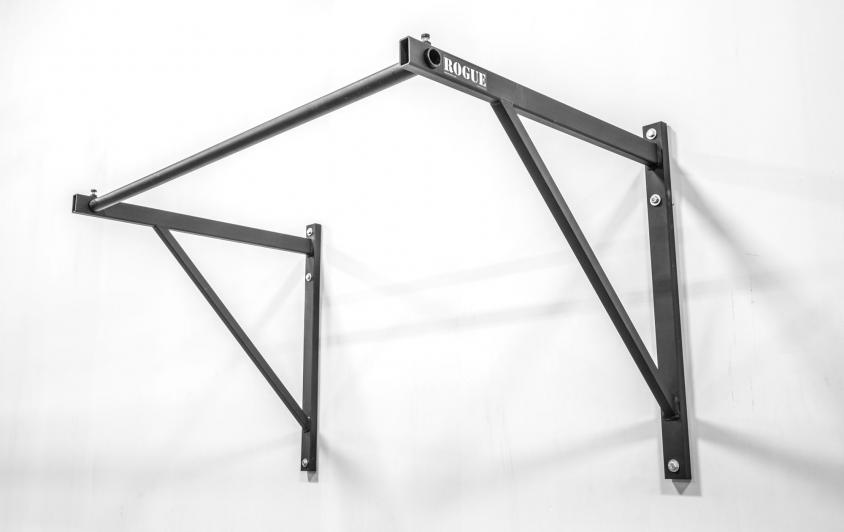A wall-mounted pull-up bar is a great option for users who want to build a dedicated setup only for doing pull-ups. Contradictory, with a hint of ingenuity and training experience, and a few training accessories a simple wall-mount pull-up bar can be turned into quite a versatile piece of home gym equipment.
The ones reviewed in this post provide plenty of clearance from the wall, giving you enough space for a variety of exercises while providing more than enough sturdiness and thus safety.
Pull-ups and chin-ups are cornerstones of functional bodyweight and strength training and quite taxing to the body compared to other bodyweight exercises. However, for this very reason, they also give you the most gains per time.
Wall-mount versions are the most common type of pull-up bars due to their simplicity and superior stability, though it’s easy to get lost in all the fancy models out there and neglect the basic criteria. Still if you’re about to fancy it up, read my comprehensive review of the most common pull-up bars for home workout and calisthenics.
Quick Review and Ratings of the Best Wall-Mounted Pull-Up Bars
Find a more detailed review of my recommended models below.
REVIEWS
Rogue P-4 Pull-Up System
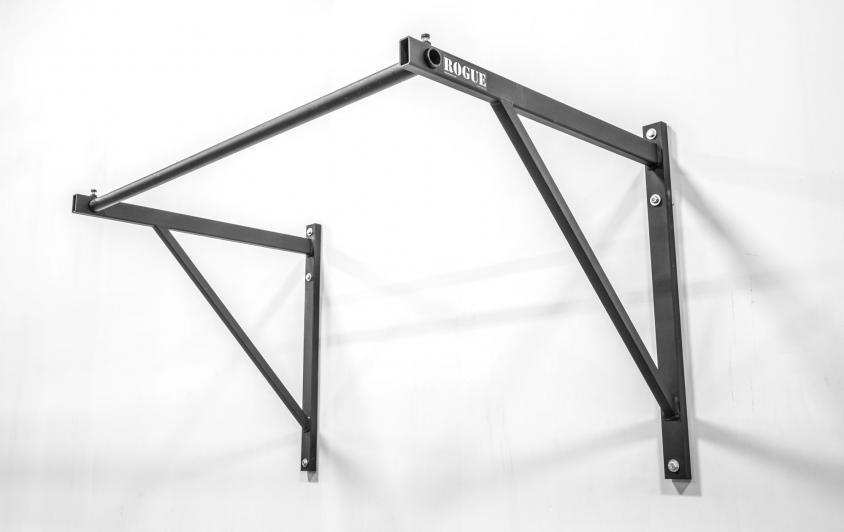
The Rogue P-4 Pull-Up System is composed of 11 gauge steel and is fully welded together to provide a stable frame with a total weight capacity in excess of 500 pounds. It also utilizes two 31-inch mounting supports to provide plenty of stability when hung both on the wall or ceiling.
However, because of the 30 inches of clearance, having extra room space or a ceiling higher than 9.5 feet is best, depending on where you plan to mount your pull-up system. It is bolted into studs with three bolts on each support, and it can be mounted into either wood or concrete.
This gives space for any exercise, including kipping, swinging, or muscle-up movements. This unit also provides versatility when it comes to installment. If you have multiple P-4 pull up systems, you can daisy chain them together, connecting multiple systems with a long, single bar.
PROS:
- Weight capacity of over 500 pounds
- 30 inches of clearance between the wall and bar
- 31-inch mounting supports to provide extra stability
- Ability to daisy chain multiple systems together for a long bar setup
CONS:
- No mounting hardware included
ECOTRIC 50” Heavy Duty Wall Mounted Chin Pull Up Bar

The ECOTRIC 50” Heavy Duty Bar utilizes two L-shaped brackets with mounting plates that are 31 inches long. Three bolts are used to mount each bracket into a stud.
This design provides high stability and can support up to 500 pounds, which should be enough for any exercise or attachment you plan to hang on the bar.
This pull-up bar provides 30 inches of clearance between the bar and the wall, which leaves plenty of room for kipping pull-ups, muscle-ups, or front levers. The bar setup also allows you to install the brackets various distances apart if your stud spacing requires it.
PROS:
- 31-inch mounting brackets to provide extra stability
- Total weight limit of 500 pounds
- A bar-to-wall distance of 30 inches
CONS:
- None
Gronk Fitness Wall Mounted Pull Up Bar

One of the biggest benefits of this product is the variety of grip options it offers. It utilizes a two-bar design with other bars spanning the distance. It includes grips for pronated, supinated, angled, and neutral grips at wide, narrow, intermediate widths. The ends of the bars are also angled, making wide grip pull-ups more comfortable and joint-friendly.
The Gronk Fitness Pull Up Bar boasts the highest weight limit of all the products I reviewed at 800 pounds, and the mounting plates on this product are 20 inches in length. This should be sufficient for the majority of users, but all of our other products offer longer supports.
Another important thing to note is that there are only 12 inches of space between the inner bar and the wall. This makes performing exercises on the inside bar or swinging movements more difficult.
PROS:
- Weight limit of 800 pounds
- Grip variations for pronated, supinated, neutral, and angled grips at different widths
CONS:
- Only 12 inches of space from inside bar to the wall
- 20-inch vertical mounting attachments
Titan Fitness Wall-Mounted Pull Up Chin Up Bar

The Titan Fitness Pull-Up Bar is designed with two L brackets made out of 11-gauge steel. These brackets have vertical mounting plates that measure 31 inches in length to provide stability for a variety of exercises. The bar is installed 30 inches away from the wall to give clearance as well.
Just like the Rogue P4 Pull-Up Bar the Titan bar can be daisy-chained as well if you purchase extra L brackets.
This setup provides a total weight capacity of 500 pounds. One thing that you should keep in mind is that the mounting hardware tends to have quality issues as many users noted. In order to ensure optimal safety and product stability, you should purchase new lag bolts for mounting.
PROS:
- 500-pound weight limit
- 31-inch vertical mounting supports to provide stability
- 30 inches of clearance between the bar and the wall
- Can be daisy-chained for multiple people workouts
- 1.3″ bar diameter
- 53″ bar length
CONS:
- Quality control issues with mounting hardware
How to Choose a Wall-Mounted Pull-Up Bar – Buying Guide
Wall-mounted pull-up bars are a great addition to any home gym. But, are they a better option than ceiling-mounted versions. Actually, you might not even need to make this decision. The majority of wall-mounted models can also be installed to the ceiling. It all comes down to your preferences, the sturdiness of your wall, and the capabilities of your apartment or garage gym.
In general, wall-mounted models can withstand large loads and are designed for heavy use, including kipping and muscle-up exercises. This is mainly because wall-mounted bars are perpendicular to the wall, so the frame actually pulls the studs into the wall tightening them, instead of pulling them out.
When you’re deciding on which wall-mounted pull-up rack to buy, there are a few things that you should be sure to keep in mind.
Above all, picking the proper home pull-up bar mostly depends on the variety of exercises, and the amount of space you have available. With both, usually the more the better.
Wall-Mount Pull-Up Bar Exercises
Do you enjoy doing callisthenic exercises? Do you plan to use your bar to do muscle-ups, front levers, skin the cats, etc? If so, you’ll need to choose a bar with a higher weight limit and one that offers plenty of stability. In most cases, the longer the mounting supports, the more stable the pull-up bar will be.
For a few examples of what you can do on your pull-up bar, check out the following video:
Bar Frame Design
Even though wall-mount pull-up bars are designed as simple as a nail, there are a few fundamental differences with regards to their shape and hence their usability.
T-Shaped Pull-Up Bars

Viewed from the side if a pull-up bar is shaped like a T, it is most reliable when mounted on a ceiling. That is because the two lever arms that the bar is connected to, have little sagittal and vertical support. A common way manufacturers stabilize the two lever arms is by using a triangle-shaped steel plate either bolted or welded to hold the T junction together.
This piece of steel triangle is usually way too small to provide proper vertical support, especially if you are planning to perform weighted pull-ups. If you mount a T-shaped bar to the wall, the line of pull will be perpendicular to the supporting triangle brackets (greatest lever at 90 degrees) and won’t provide as much stability as if the direction of force was parallel (no lever force in this case).
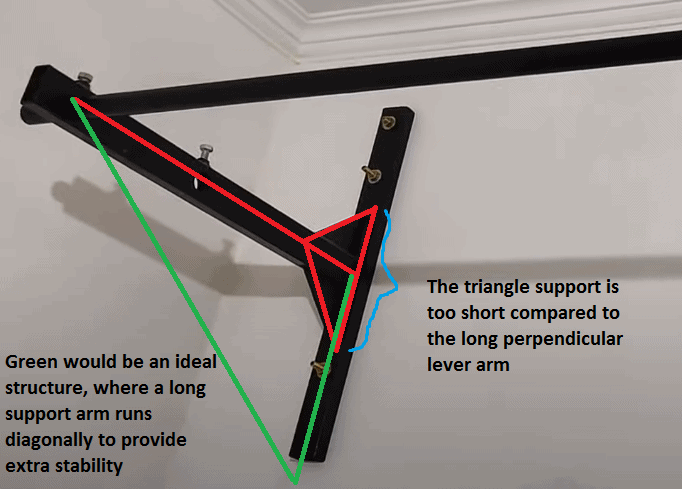

I haven’t included such products because their stability is severely lacking. This makes them less ideal in general, but especially for wall-mounting and for people who want to do exercises that utilize momentum or swinging.
Therefore it’s better to mount T-shaped designed pull-up bars to the ceiling. This way the lever arms are exposed to rather parallel—in this case vertical—, and less sagittal forces.
But even then I would stay away from T-shaped pull-up bars, especially from mounting it to the wall.
L-Shaped Pull-Up Bars
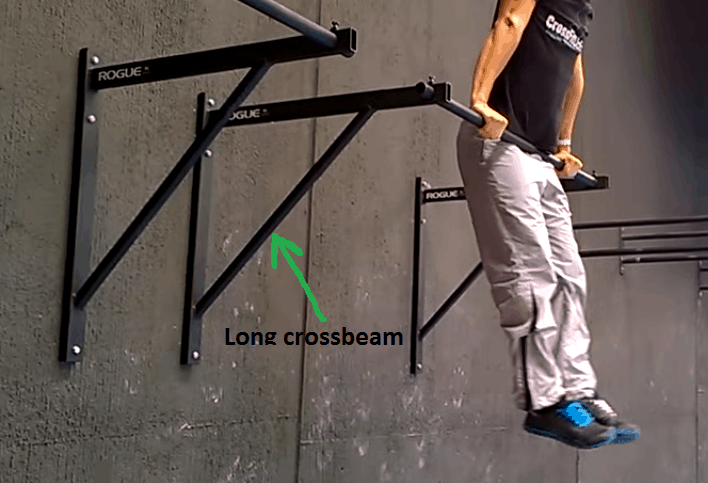
While these units are typically designed for wall mounting, they can also be used on the ceiling as long as the mounting support beams are wide enough. The L-shaped design is generally a better option for wall-mounting because it offers a larger support angle with its long crossbeams. This is especially important for products with longer lever arms and more wall clearance such as Rogue pull-up bars.
Mounting Support Too Short
Another common issue with mountable pull-up bars is when their metal stems or plates—drilled against the wall—, are too short in length. Obviously, the longer way the metal beams can lie against the wall the better vertical stability the frame will provide.
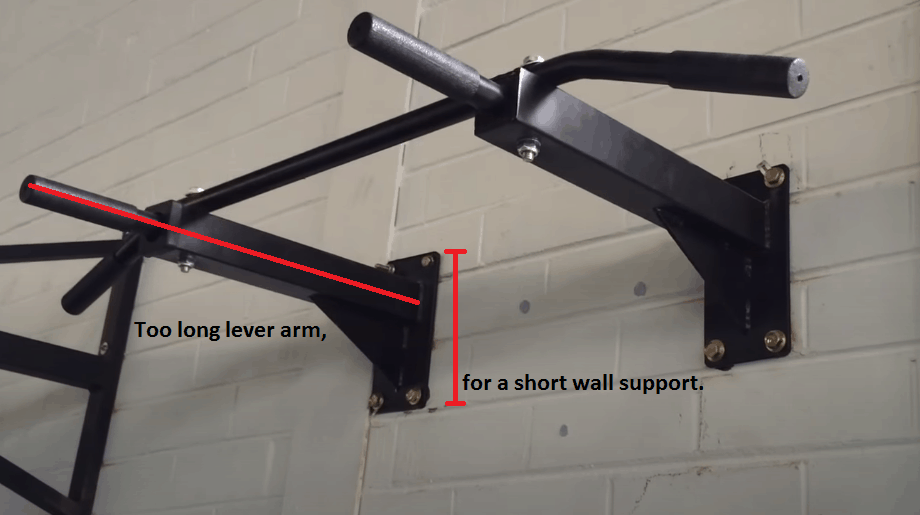

Stall bar mountable pull-up bars used by schools and gymnastic facilities are a great example. They are often manufactured with a thin metal frame, but a long diagonal stabilizing rod goes a long way to make up for the lightweight design, to provide excellent sagittal and vertical stability.
Wall Clearance
In addition to the product design, one of the most important factors to take into account is wall clearance—unless you mount your bar above the door, such as doorway-mounted pull-up bars. The more space there is between the bar and the wall the better. But keep in mind, as mentioned above, that requires more stability thus a bulkier product in general.
Some products have limited space, which can make kipping movements, front lever variations, and other exercises with horizontal space requirements more difficult to do. With ample wall clearance, you can let go of your fantasy with regard to possible exercise variations.
Be sure to find a product with ample space between the bar and the wall—or the ceiling for that matter—, which means carefully checking lever arm length dimensions.
Versatility
It’s a no-brainer, if you workout at home, you need multipurpose home gym equipment.
And while a pull-up bar doesn’t really get any more multipurpose than just being a straight piece of steel tube, there are some features that can add value to your home training.
These are typically multiple grip options or attachment points for accessories. Some wall-mount pull-up bars, like the Gronk Fitness Bar, have multiple grip crossbars that allow for different pull-up variations.
If you plan to use other attachments, such as punching bags, straps, ropes, or TRX for diverse suspension training, make sure that your selected bar is up for such accessories featuring:
- a high enough weight limit
- stability in all directions
- mounting anchor hooks for boxing bags, suspension trainers, bands, cable pulleys etc.
- longer lever arms aka enough space from the wall to be used with such accessories.
Mounting Your Pull-Up Bar Safely
Whether you mount your pull-up bar on the ceiling or the wall, aligning it with studs is critical. Most products measure 48 inches in width, making them compatible with any stud spacing.
While installing the mounting arms into the studs, to provide enough stability, it’s never a bad idea to have some extra reinforcement. If possible, placing extra 2x4s into the wall can further increase stability and extend the life of your pull-up bar and protect your walls from damage.
If you are unable to mount your pull-up bar directly onto the studs, due to uneven stud spacing or room size limitations, placing larger boards, such as 1x6s or 2x6s, horizontally across the studs and attaching the pull-up bar to those is also an option. If you do install your bar this way, be sure to solidly bolt each of the horizontal boards into the studs and the pull-up bar into the boards.
Another thing to keep in mind is how much clearance you need above the bar. If you have a lower ceiling, be sure that you mount your bar at least low enough that you have enough clearance for your head above the bar. Having a bit of extra vertical space enables you to do muscle-ups and other over-the-bar exercises. Make sure to leave at least 30 inches or so above the bar to give yourself enough room.
Finally, if there’s no hope left, your walls are not secure enough to hold a wall-mounted pull-up bar—plus your bodyweight—, you might want to consider a free-standing pull-up rack. As its name implies, it is a standalone pull-up rig, loading only your floor, this way you don’t really have to worry about weight limits. The only downside is, it takes up more space. On the upside, it can be pimped into a home workout powerhouse!
Mounting Hardware
When it comes to mounting pull-up bars, many of the negative reviews mention that the mounting hardware is low in quality. However, the bars themselves are often more than well-made and quite durable.
Even if a product’s mounting hardware does not receive negative reviews, it may be a good idea to purchase more robust hardware. Getting lag bolts that are thicker or longer can increase product stability and increase the life of your product, not to mention giving peace of mind while hanging upside down…
A Word About DIY Pull-Up Bars
If you are fond of crafting, I encourage you to try making your own aka DIY pull-up bar. The reason being, in general, is that iron is relatively cheap, and it’s easy to work with closed profile tubes. If you are into welding that’s even better, then you don’t even need to hire a locksmith.
Yes, it may take a while but the result may very well be worth it. There are only a few workout equipment giving this much bang for your buck or effort for as little maintenance as a homemade pull-up bar needs. It has zero moving parts, and if you do a thorough job it will last a lifetime.
Before you jump into it listen for a sec. I made my own squat stand and heed my advice: the one and biggest mistake you can make is not cutting the ends straight. Obviously, this is going to result in the arms not being level with each other and instead straight lines, your pull-up bar will be all over the place. Plus it’s going to be harder to weld the pieces together as they won’t fit tight. What could also be really annoying is that it might not even stand flat against the wall.
So if possible ask the shop to precision cut the parts for you, show them your drawings and exact dimensions, that way you’ll save a lot of headaches later. Believe me, it’s really hard to cut straight lines on closed profile tubes especially if you don’t have the special tools. Yes, you can mess up the drilling too, but it’s way easier to correct, a cheaper and more forgiving mistake.
In my opinion, a pull-up bar is among the easiest DIY home gym equipment. As a general rule of thumb, the more simple, the better.
My 4 favorite DIY pull up bar design options that stand the test of time:
- A pull up bar hanging from 2 straps such us the one my client crafted in 5 minutes during the Covid-19 period.
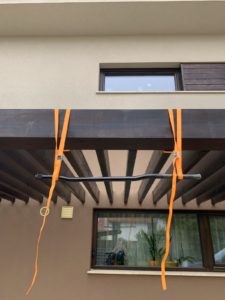
- Also, Rogue offers the same solution with its Individual Pull-Up System.
- A T shaped one, best used as a ceiling-mounted pull-up bar, or a triangle-shaped wall-mounted bar such as the Rogue P-4 Pull up System reviewed below.
Carefully crafted, these DIY pull-up bars will be up to par with anything you can buy on the market, irrespectively of whether they have been designed for a home workout or for commercial use. Provided you pick quality material, sturdy bolts, wooden reinforcement, etc.
Though for those of you who don’t want to bother with a DIY pull-up bar, find my review of the best and most reliable wall-mounted versions below.
Conclusion
The winner of the best wall-mounted pull-up bar review is the Rogue P-4 Pull-Up System, though this was a hard one. The Titan Fitness Wall-Mounted Bar is a strong runner-up, had it not been for the quality issues, I would consider it completely identical to the Rogue P-4.
As far as space requirements go, the Rogue P-4 pull-up bar provides 30 inches of clearance, which leaves plenty of space for any type of exercise. Should you go after bodyweight calisthenics or weighted chin-ups, this product with its quality welding makes a much-needed sturdy structure, though enhanced safety.
The Rogue P-4 comes with a weight limit of more than 500 pounds and offers 31-inch mounting supports. The L-shape design provides a large angle of support and increased stability.
The Rogue signature powder coat finish provides a twofold advantage over other products: It ensures a tight grip when squeezed harder, but still allows smooth friction when we loosen our grip for more dynamic exercises such as a kipping pull-up, that way preventing skin tears on the hands.
Overall, the Rogue P-4 Pull Up System is a great all-around unit, representing the highest quality which makes it the clear winner of this best wall-mounted pull-up bar review.

